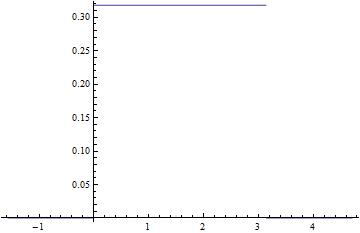Exercise 2 Consider the first
|
Exercise 3 The needle on a broken car is free to swing, and bounces perfectly off the pins on either end, so that if you give it a flick it is equally likely to come to rest at any angle between
|
Exercise 4
|
Exercise 5 The probability density is
|
— Mathematica file —
The resolution of exercise 2 was done using some basic Mathematica code which I’ll post here hoping that it can be helpful to the readers of this blog.
// N[Pi, 25]piexpansion = IntegerDigits[3141592653589793238462643]
digitcount = {}
For[i = 0, i <= 9, i++, AppendTo[digitcount, Count[A, i]]]
digitcount
digitprobability = {}
For[i = 0, i <= 9, i++, AppendTo[digitprobability, Count[A, i]/25]]
digitprobability
digits = {}
For[i = 0, i <= 9, i++, AppendTo[digits, i]]
digits
j = N[digits.digitprobability]
digitssquared = {}
For[i = 0, i <= 9, i++, AppendTo[digitssquared, i^2]]
digitssquared
jsquared = N[digitssquared.digitprobability]
sigmasquared = jsquared - j^2
std = Sqrt[sigmasquared]
deviations = {}
deviations = piexpansion - j
deviationssquared = (piexpansion - j)^2
variance = Mean[deviationssquared]
standarddeviation = Sqrt[variance]
